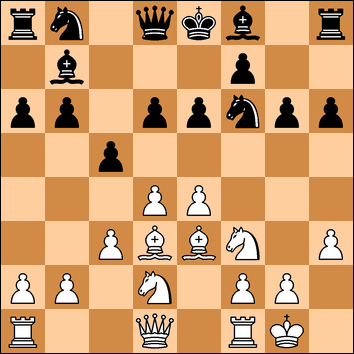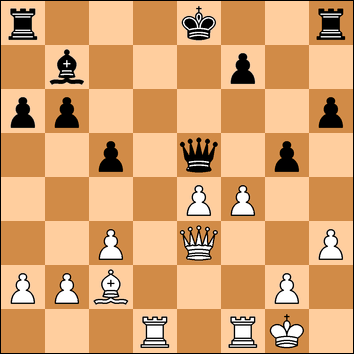Thursday 19 May 2016
White: K. Nevols (132) - Black: I. Lappin (132)
I calculated that I needed to win my last two games to be sure of third place. In the first round of games, I was fortunate to defeat my opponent in a crazy game and so resolved to play more calmly and positionally this time.
1. e4 g6
2. d4 b6
Not sure what this is called. Perhaps the double fianchetto. I just decide to calmly develop keeping things defended in the centre.
3. Be3 a6
4. Nf3 Bb7
5. Nbd2 Nf6
6. Bd3 h6
I have to confess to being unfamiliar with the system that Black is using. It's a sort of Indian defence, where Black allows White to set up a centre and intends to undermine it. The addition of the moves a6 and h6 might be leaning towards a sort of hedgehog set-up.
7. h3
To prevent any ideas of Ng4 after Bg7.
7. ... e6
8. O-O c5
9. c3 d6

So I am ahead in development and I have the centre so I must now think of a plan. Placing the queen opposite his undeveloped king seemed an interesting plan. 10. a4 is the computer's suggestion aiming at queenside play.
10. Qe2 Nbd7
Although this keeps the diagonal open for the queen's bishop, I felt it lacked ambition and that Nc6 would have been better for Black. With nothing happening much on d4, and the possibility of a central attack against the un-castled king, I decide to redeploy my Bishop to a better diagonal.
11. Bf4 Nh5
12. Bh2 Bg7?
Was this a pawn sacrifice or a mistake? I gave it careful thought. The lines I could see for Black after Bxd6 involved an attempt to trap the bishop and play in the centre with e5 and Nf4.
Although Bxd6 is the obvious move, a far better move for White would be 13. Nc4! to take the pawn with the knight. Then 13. .. O-O 14. Nxd6 and Black's a-pawn is about to go as well. (If 14. .. Qc7 then 15. g4! Nhf6 16. Nxf7).
However I did not see that option and after assessing if I could eat up the pawn thought .. well, why not?
13. Bxd6 e5
14. Qe3
This was the move I had foreseen. If 14. dxe5 then I thought Black would win a piece with 14. ... Nf4 15. Qe3 Nxd3 16. Qxd3 Nxe5 17. Nxe5 Bxe5. But I had overlooked that 18. Nc4 (perhaps followed by moving a rook to d1) would save the day.
14. .... Nf4
15. Bc2 g5
16. dxe5
The computer thinks taking with the knight is better but I was concerned about the bishop getting cut off and wanted to exchange it and keep the pressure in the centre.
16. ... Ng6
17. Rad1 Ngxe5
18. Bxe5 Bxe5
19. Nxe5 Nxe5
20. Nc4 Qc7
21. Nxe5 Qxe5
22. f4!

This was the position I had envisaged at move 16. I am a pawn up with my heavy pieces in the centre of the board aiming at his uncastled king. After the game we spent some time looking at this position as to whether Black could hold. We looked at 22. ... Qf6. 23. e5 Qc6 (24. Rd2 seems to hold meeting 24. .. Rg8 with 25. f5) and 22. ... Qg7 (where 23. Rd6 is a good move).
The view of the computer is that Black played the best move - and that his mistake comes later.
22. ... gxf4
23. Qxf4 Qe6?
The computer thinks this is the mistake. Better would be 23. ... Qxf4 24. Rxf4 Ke7 25. Rdf1 Raf8. After 26. Rf6 White is still much better although the text allows White to finish quicker by winning a pawn and getting the bishop in.
24. Rd6 Qe7
25. Rxb6 Bc8
26. Ba4+ Bd7
27. Bxd7 Qxd7
28. Qe5+
Of course if 27. .. Kxd7 then 28. Rb7+. Now Black will lose a rook and so decided to resign.
No comments:
Post a Comment